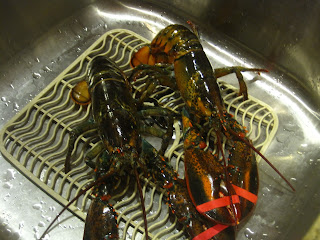As I related my birthday dinner, rack of lamb, to friends and family, I was imagining fruit. Ripe fruit is naturally perfect. Imagine a ruby-red strawberry in the peak of summer. As it sits in your hand, you can tell it is soft, but not yet mushy. You bite into it. It does not taste like those freezer-burned, strawberry-flavored ice cubes we call “fresh frozen”; it tastes like cool shade on a hot day. To call it ‘sweet’ would be irreverent. The flesh dissolved into syrup on your tongue. No need for sugar, salt, preservatives….it is perfect.
Lamb must the ‘fruit’ of red meat, naturally perfect. Before cooking, we let only fresh herbs and garlic exfoliate the lamb. Once it hit the hot cast-iron, it sizzled viciously. We watched the lamb sear to a just-blackened crisp, becoming plump and succulent. As we gently pressed on the middle, it bulged, impregnated with juices. Lifted from the scorching skillet, it rested on a red oak cutting board; boldly steaming with fragrant herbs and garlic. We put it on a plate. After peeling off the blanket of fat, delicate, purple flesh was revealed. We tried slicing up the first small bites civilly. (Eyes roll back into head) The romantic “candlelight dinner” devolved into hedonistic finger-licking and bone-sucking. We smiled as meaty nectar dribbled from the corner of our mouths.
The best part: we each had two ribs. The second best part: no mint jelly.
Lamb, you really are perfect just the way you are.
Lamb + Marinade
Ingredients:
1 rack of lamb, frenched
4 T Olive Oil
4 cloves garlic, whole
1 T mint leaves, whole
2 sprigs of rosemary
Dash of salt and pepper
Instructions:
1. Put all ingredients, except the lamb, in food processor. Blend into light paste.
2. Cover each side of lamb rib with marinade.
3. Let sit until lamb has been brought to room temperature.
4. Heat a cast-iron skillet over high heat until very hot. Place lamb into skillet
5. Sear until crisp and just-blackened (about 3 min per side).
**Meat should be about as tender as the muscle underneath your thumb when you place your thumb and index finger together.
6. Let meat rest (covered in tin foil) for about 5-10 minutes.
DEVOUR.




























